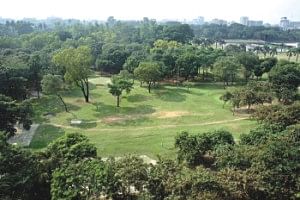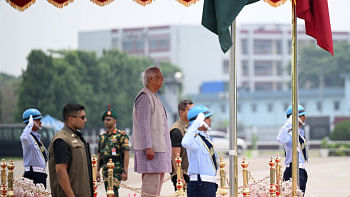Of Suhrawardy Udyan, of history and golf

Photo: Anisur Rahman
The Dhaka Club authorities have come forth with their own version of what they have been trying to do about Suhrawardy Udyan, and to it. They surely have all the right in the world to respond to the criticism that has lately been leveled at them over a golf course in the park.
In manner most Mark Antony-like (Caesar has left everything of his for his beloved Romans), the club authorities have informed the country that citizens will have easy and uninterrupted access to the golf course, that indeed Dhaka Club has only taken it upon itself to ensure that the golf course in Suhrawardy Udyan is maintained in a decent manner.
They have also reminded us that Dhaka Club happens to be the owner of Suhrawardy Udyan, once known as the Race Course, and that, over the decades since the departure of the British colonial power, its proprietary rights over the grounds have gradually shrunk. Most interestingly, perhaps even intriguingly, they have told us that they mean to popularise golf among the general masses, that indeed any citizen can make use of the golf course to practice his hand at playing the game.
All so very well. But there are quite a few points that come up in light of media reports over the grant of 25 acres of Suhrawardy Udyan, out of approximately 68 acres, to the club and the club's response to such reports. Should we go into those points? Let it suffice, for now, to remember that if, during the British and Pakistani colonial eras, Dhaka Club served as an exclusively elitist club for its members, we understand. In these present times, if the club means to maintain its exclusive character, we do not mind that either.
But where the question relates to Suhrawardy Udyan, we will recall that, especially since 1969, it has served as a symbol of certain fundamental Bengali political aspirations. In that momentous year, Sheikh Mujibur Rahman was transformed into Bangabandhu at a public rally in what used to be the Race Course a day after he was freed from the Agartala conspiracy case.
Two years later, on March 7, 1971, the Udyan acquired a definitive historic character when Bangabandhu pointed out the road to Bengali freedom through oratory that was as lofty as it was intellectually stimulating; Olympian grandeur we have never had cause to forget.
The historic was given a fresh layer of authenticity when General Niazi surrendered, with his 93,000 soldiers, to the India-Bangladesh joint command at Suhrawardy Udyan on December 16, 1971. Pakistan, happily for Bengalis, breathed its last at the Udyan.
It is this legacy that we need to keep alive. It is as much a responsibility of environmentalists as it is of history buffs and Dhaka Club to make certain that a place which has so much of history attached to it does not lose itself in such quagmires as golf courses and the like. Of course, in the past many decades, the Udyan has taken a bad beating through such edifices as the Institution of Engineers and the Roads & Highways Department appropriating considerable portions of its spaces.
In the times of General Ziaur Rahman, the bad move of building a children's park inside the Udyan sent the knife twisting through our tradition. Once that was done, it was the historic character of the Udyan that was left undermined.
To be sure, a shwadhinota stambha, or independence monument, is there, incomplete because the government that succeeded Sheikh Hasina's in 2001 was too driven by vindictiveness to follow through on the project. There may come a day when the monument finally turns out to be a true, tangible testimony to our liberation as a people. For now, we will pray that no one tampers with the edifice as it exists. But have you noticed that many of us actually face difficulties trying to locate the exact spot from where Bangabandhu gave out his call for freedom? Ask the sceptics. They will tell you that it has been devoured by the Shishu Park. Much a similar opinion is there about the Indira Mancha, built in 1972 to commemorate Indira Gandhi's visit to Bangladesh.
If Suhrawardy Udyan has endlessly served as a metaphor for some of the greatest moments in Bengali national life, it has also gone through quite a few stumbles where preserving or reasserting history is concerned. Think of the Kali Mandir that was so paramount a landmark in the old Race Course. Old film footage of the grounds bears testimony to the symbolism of the temple. In the early hours of their genocide, Pakistan's soldiers pulverised the Kali Mandir into dust, for it had been a reflection of Hinduism in a Muslim land. And Hindus, if you recall, did not matter in Pakistan.
Once the war was over, though, it ought to have been for the government of Bangladesh to have the temple reconstructed. Leading figures of the Hindu community did indeed ask that the Kali Mandir, like the Shaheed Minar, come up again. Bangabandhu Sheikh Mujibur Rahman, for reasons that remain shrouded in mist, remain inexplicable as it were, displayed no great enthusiasm for the idea. So that meant a vital facet of the Suhrawardy Udyan story being stripped away. That was the beginning. And today we must confront the issues that have been raised around Dhaka Club's plan for a golf course, one it says has always been there.
The plain point we can make here relates to the club's thought that it means to turn golf into a sport of the masses. That does not sound like a terribly good idea, for the simple reason that golf has always had, and all across the globe, an elitist touch to it. In Bangladesh's instance, there are all the ground realities that we cannot ignore, one of these being the truth that citizens who wage a daily struggle for decent living should not be expected to play golf.
But what they can do is to take a breather, through walks in the few parks that we have in this city; they need to be reassured that they will not feel intimidated by such enclosures as golf parks in spaces that have traditionally been a preserve of citizens. Dhaka Club promises us that it will keep the 25 acres in question in good shape. Isn't that a responsibility of the Public Works Department?
We raise the question because of our worries over the elitism, the culture of exclusion, that has of late taken hold of those who have ruled or have tried to rule us. The simple truth at this point, whether or not you accept it, is that the common man in Bangladesh does not much matter. He cannot go over from one side of the road to another because a VIP means to travel down the road. The underpass is closed off to him because, at that point, he could be a security risk!
We could go on and on and on. There are the thousand and one pains we go through every livelong day. But we will let that be. For now, we will ask that Suhrawardy Udyan stay as it has so far, that it remain in possession of the citizen. If Dhaka Club is driven by an urge to add to the beauty of the place, let it do so through other means and in different ways. A golf course is not emblematic of beauty or aesthetics, in a country where millions of people wonder where their next meal is going to come from.
Syed Badrul Ahsan is Editor, Current Affairs, The Daily Star.

 For all latest news, follow The Daily Star's Google News channel.
For all latest news, follow The Daily Star's Google News channel. 



Comments